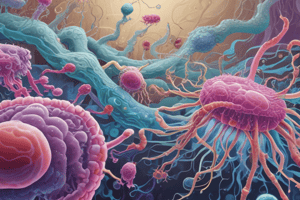Podcast
Questions and Answers
Which of the following bacteria is a Gram-negative cocci?
Which of the following bacteria is a Gram-negative cocci?
- Proteus mirabilis
- Salmonella typhimurium
- Escherichia coli
- Neisseria meningitidis (correct)
Which family do Enterobacteriaceae bacteria belong to?
Which family do Enterobacteriaceae bacteria belong to?
- Gram-negative cocci
- Anaerobic Gram-negative bacteria
- Spirochetes
- Gram-negative rods (correct)
Which of the following bacteria reduces nitrates to nitrites?
Which of the following bacteria reduces nitrates to nitrites?
- Moraxella catarrhalis
- Klebsiella pneumoniae (correct)
- Shigella dysenteriae
- Neisseria gonorrhoeae
Which one of the following bacteria resides in the gastrointestinal tract of animals and humans?
Which one of the following bacteria resides in the gastrointestinal tract of animals and humans?
Which bacteria is commonly associated with causing meningococcal disease?
Which bacteria is commonly associated with causing meningococcal disease?
Which of the following bacteria is a Spirochete?
Which of the following bacteria is a Spirochete?
Which antigen is associated with the flagellar antigen of motile cells only?
Which antigen is associated with the flagellar antigen of motile cells only?
What is the identifying feature of Escherichia coli strains on MacConkey agar?
What is the identifying feature of Escherichia coli strains on MacConkey agar?
Which test is used to identify the presence of urease enzyme in bacterial species?
Which test is used to identify the presence of urease enzyme in bacterial species?
In capsulated strains of Klebsiella, which antigen is masked by the K antigens?
In capsulated strains of Klebsiella, which antigen is masked by the K antigens?
What is a common source of transmission for enterohemorrhagic strains of Escherichia coli?
What is a common source of transmission for enterohemorrhagic strains of Escherichia coli?
Which genus possesses five O antigens, with O antigens being identifiable only in non-capsulated mutants?
Which genus possesses five O antigens, with O antigens being identifiable only in non-capsulated mutants?
What is the distinguishing feature of klebsiella bacteria?
What is the distinguishing feature of klebsiella bacteria?
What is the main disease caused by Klebsiella pneumoniae in community-acquired settings most often affecting older men with chronic lung disease, alcoholism, or diabetes?
What is the main disease caused by Klebsiella pneumoniae in community-acquired settings most often affecting older men with chronic lung disease, alcoholism, or diabetes?
Which antibiotic is commonly used for treating Klebsiella pneumoniae infections, particularly those caused by ESBL-producing strains?
Which antibiotic is commonly used for treating Klebsiella pneumoniae infections, particularly those caused by ESBL-producing strains?
What is the primary method of transmission for Shigella bacteria?
What is the primary method of transmission for Shigella bacteria?
Klebsiella pneumoniae is a motile bacterium
Klebsiella pneumoniae is a motile bacterium
Shigella bacteria are Gram-negative rods
Shigella bacteria are Gram-negative rods
Salmonella capsular antigen is also known as the O antigen
Salmonella capsular antigen is also known as the O antigen
Escherichia coli strains are identified by their O, H, and K antigen serotypes
Escherichia coli strains are identified by their O, H, and K antigen serotypes
Klebsiella pneumoniae is a spore-forming bacterium
Klebsiella pneumoniae is a spore-forming bacterium
Klebsiella pneumoniae is oxidase positive
Klebsiella pneumoniae is oxidase positive
Escherichia coli ferments lactose
Escherichia coli ferments lactose
Shigella flexneri is a Gram-positive bacterium
Shigella flexneri is a Gram-positive bacterium
Salmonella is part of the Enterobacteriaceae family
Salmonella is part of the Enterobacteriaceae family
Shigella bacteria are commonly associated with causing urinary tract infections
Shigella bacteria are commonly associated with causing urinary tract infections
Neisseria gonorrhoeae is a Gram-positive bacterium.
Neisseria gonorrhoeae is a Gram-positive bacterium.
Salmonella enteritidis is a member of the Enterobacteriaceae family.
Salmonella enteritidis is a member of the Enterobacteriaceae family.
Yersinia pestis is a facultative anaerobe.
Yersinia pestis is a facultative anaerobe.
Proteus mirabilis is a member of the Non-Enterobacteriaceae Bacteria.
Proteus mirabilis is a member of the Non-Enterobacteriaceae Bacteria.
Neisseria meningitidis is a Spirochete.
Neisseria meningitidis is a Spirochete.
Escherichia coli is cytochrome C oxidase positive.
Escherichia coli is cytochrome C oxidase positive.
Flashcards are hidden until you start studying




